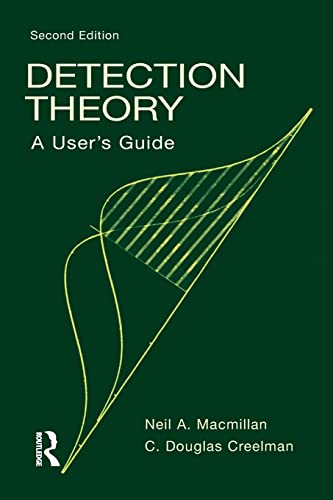Detection Theory: A User's Guide
Neil A., Macmillan
Librería:
WorldofBooks, Goring-By-Sea, WS, Reino Unido
Calificación del vendedor: 5 de 5 estrellas
![]()
Vendedor de AbeBooks desde 16 de marzo de 2007
Descripción
Descripción:
The book has been read, but is in excellent condition. Pages are intact and not marred by notes or highlighting. The spine remains undamaged. N° de ref. del artículo GOR012398382
Sinopsis:
Detection Theory is an introduction to one of the most important tools for analysis of data where choices must be made and performance is not perfect. Originally developed for evaluation of electronic detection, detection theory was adopted by psychologists as a way to understand sensory decision making, then embraced by students of human memory. It has since been utilized in areas as diverse as animal behavior and X-ray diagnosis.
This book covers the basic principles of detection theory, with separate initial chapters on measuring detection and evaluating decision criteria. Some other features include:
*complete tools for application, including flowcharts, tables, pointers, and software;
*student-friendly language;
*complete coverage of content area, including both one-dimensional and multidimensional models;
*separate, systematic coverage of sensitivity and response bias measurement;
*integrated treatment of threshold and nonparametric approaches;
*an organized, tutorial level introduction to multidimensional detection theory;
*popular discrimination paradigms presented as applications of multidimensional detection theory; and
*a new chapter on ideal observers and an updated chapter on adaptive threshold measurement.
This up-to-date summary of signal detection theory is both a self-contained reference work for users and a readable text for graduate students and other researchers learning the material either in courses or on their own.
Acerca del autor: Charlotte y Peter Fiell son dos autoridades en historia, teoría y crítica del diseño y han escrito más de sesenta libros sobre la materia, muchos de los cuales se han convertido en éxitos de ventas. También han impartido conferencias y cursos como profesores invitados, han comisariado exposiciones y asesorado a fabricantes, museos, salas de subastas y grandes coleccionistas privados de todo el mundo. Los Fiell han escrito numerosos libros para TASCHEN, entre los que se incluyen 1000 Chairs, Diseño del siglo XX, El diseño industrial de la A a la Z, Scandinavian Design y Diseño del siglo XXI.
Detalles bibliográficos
Título: Detection Theory: A User's Guide
Editorial: Psychology Press
Año de publicación: 2004
Encuadernación: Paperback
Condición: Very Good
Edición: 2ª Edición
Los mejores resultados en AbeBooks
Detection Theory: A User's Guide
Librería: HPB-Red, Dallas, TX, Estados Unidos de America
Paperback. Condición: Good. Connecting readers with great books since 1972! Used textbooks may not include companion materials such as access codes, etc. May have some wear or writing/highlighting. We ship orders daily and Customer Service is our top priority! Nº de ref. del artículo: S_420335574
Comprar usado
Se envía dentro de Estados Unidos de America
Cantidad disponible: 1 disponibles
Detection Theory: A User's Guide
Librería: Goodwill of Silicon Valley, SAN JOSE, CA, Estados Unidos de America
Condición: good. Supports Goodwill of Silicon Valley job training programs. The cover and pages are in Good condition! Any other included accessories are also in Good condition showing use. Use can include some highlighting and writing, page and cover creases as well as other types visible wear. Nº de ref. del artículo: GWSVV.0805842314.G
Comprar usado
Se envía dentro de Estados Unidos de America
Cantidad disponible: 1 disponibles
Detection Theory : A User's Guide
Librería: Better World Books, Mishawaka, IN, Estados Unidos de America
Condición: Very Good. Former library book; may include library markings. Used book that is in excellent condition. May show signs of wear or have minor defects. Nº de ref. del artículo: 54529625-6
Comprar usado
Se envía dentro de Estados Unidos de America
Cantidad disponible: 1 disponibles
Detection Theory: A User's Guide
Librería: BGV Books LLC, Murray, KY, Estados Unidos de America
Condición: Good. Exact ISBN match. Immediate shipping. No funny business. Nº de ref. del artículo: 20250916065a
Comprar usado
Se envía dentro de Estados Unidos de America
Cantidad disponible: 1 disponibles
Detection Theory: A User's Guide
Librería: Phatpocket Limited, Waltham Abbey, HERTS, Reino Unido
Condición: Good. Your purchase helps support Sri Lankan Children's Charity 'The Rainbow Centre'. Ex-library, so some stamps and wear, but in good overall condition. Our donations to The Rainbow Centre have helped provide an education and a safe haven to hundreds of children who live in appalling conditions. Nº de ref. del artículo: Z1-E-001-01504
Comprar usado
Se envía de Reino Unido a Estados Unidos de America
Cantidad disponible: 1 disponibles
Detection Theory: A User's Guide
Librería: Toscana Books, AUSTIN, TX, Estados Unidos de America
Paperback. Condición: new. Excellent Condition.Excels in customer satisfaction, prompt replies, and quality checks. Nº de ref. del artículo: Scanned0805842314
Comprar nuevo
Se envía dentro de Estados Unidos de America
Cantidad disponible: 1 disponibles
Detection Theory: A User's Guide
Librería: SHIMEDIA, Orient, NY, Estados Unidos de America
Condición: New. Satisfaction Guaranteed or your money back. Nº de ref. del artículo: 0805842314
Comprar nuevo
Se envía dentro de Estados Unidos de America
Cantidad disponible: 1 disponibles
Detection Theory: A User's Guide
Librería: BennettBooksLtd, San Diego, NV, Estados Unidos de America
paperback. Condición: New. In shrink wrap. Looks like an interesting title! Nº de ref. del artículo: Q-0805842314
Comprar nuevo
Se envía dentro de Estados Unidos de America
Cantidad disponible: 1 disponibles

